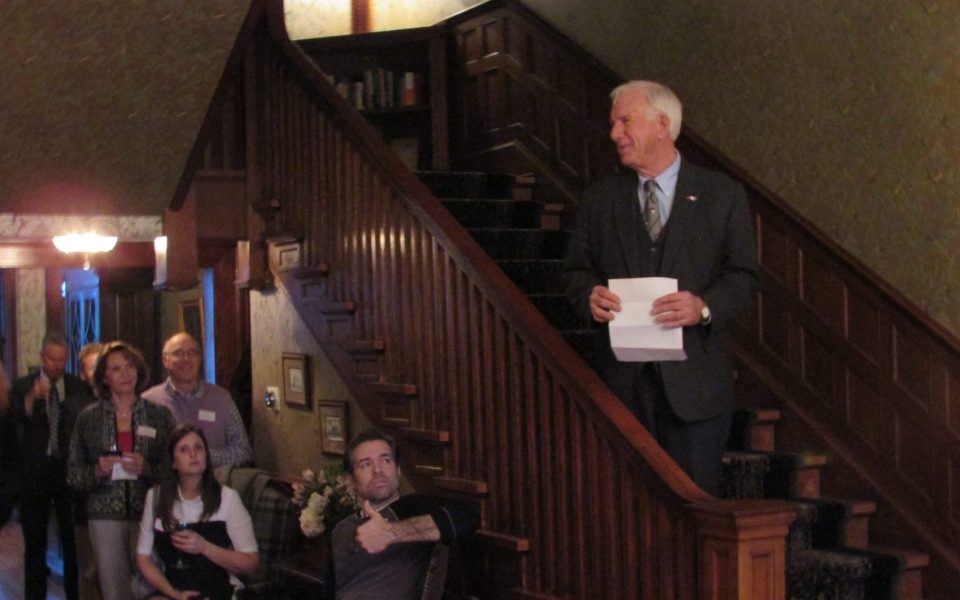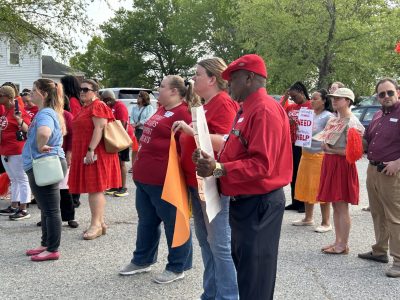Longtime members of the High Point Preservation Society are reviving the organization to take on some urgent projects while celebrating a Chicago furniture magnate’s renovation of a historic mansion as a hospitality center.
Jim Morgan, a lawyer and former state lawmaker with a legendary résumé of community leadership, stood in the staircase at the Pandora’s Manor bed & breakfast, and declared the resurrection of the High Point Preservation Society.
“We need to kind of revive and get going,” he said during a re-launch soiree on Monday.
Co-founded by Morgan in 1984, the historic preservation society has accomplished some impressive feats, including raising money to preserve and renovate the Depot, which was built by the Southern Railway in 1907, and saving the Ray Street School (also known as the Little Red Schoolhouse), but the organization is in need of reactivation.
“High Point is at a crossroads,” said Benjamin Briggs, a native and longtime resident of the city who serves as executive director of Preservation Greensboro. “We’re trying to encourage reinvestment in our historic buildings.”
Briggs introduced a slate of new members of the organization’s board of directors, with Morgan as its chair, himself as president and Coralle Cowan as secretary, along with documentary filmmaker Phyllis Bridges, Southwest Renewal Foundation Executive Director Dorothy Darr, Gloria Halstead, Mary Powell DeLille and Bill Phillips. Morgan said there were four additional seats on the board, but no one at the reception volunteered. Then the guests, who had been plied with wine and beer, approved the new board members by acclamation.
Board members, who have already been working on their own, have a couple urgent projects to tackle with the reactivated organization, but they also wanted to highlight the host venue as an example of the kind of preservation that will inject new vitality into the city.
The bed and breakfast was purchased in February 2016 by Ridvan Tatargil, owner of the Chicago-based linen manufacturer Eastern Accents, which exhibits at the nearby Suites at Market Square. Tatargil is renovating the 1905 mansion, built by Myrtle Desk Co. founder Henry Frazier, and has acquired part of a block bounded by West High Avenue, Oak Street and West Green Drive with plans for redevelopment. The first phase, which is scheduled to be complete in time for the spring furniture market in late April, includes a new grand entrance at the rear of the house adjacent to an outdoor event area and equipped with a kitchen and restrooms. The bed and breakfast will accommodate up to 12 guests, with a restaurant serving lunch and dinner that will be open to the public.
Tatargil was not present for the relaunch, but Justin Gold-Smith, who recently moved from Houston to High Point with his husband Baker Gold-Smith to manage the bed and breakfast, spoke on his behalf at the event.
“Ridvan dreams big,” Justin Gold-Smith said. The collection of properties acquired by Tatargil includes an old biker bar at the corner of West Green Drive and Oak Street. Gold-Smith said Tatargil will turn his attention to that project after completing renovations at the bed and breakfast.
“His vision is to create a restaurant, bar, maybe a brewpub to revitalize the area with services for people in the area,” Gold-Smith said.
The group of properties under redevelopment by Tatargil is part of a transitional area between the gracious String & Splinter city club and the Market Square Towers condos to the east and a declining industrial area to the southwest. Tatargil’s properties are part of 1,096-acre area identified by UNCG’s Center for Housing & Community Studies as the poorest in the city, which sweeps through the central business district.
The Census tract that covers most of the southwest quadrant where Pandora’s Manor is located includes some of the most stunning furniture showrooms, including Market Square, the Commerce & Design Building and Natuzzi Americas, which is designed to resemble a ship, along with some of the city’s areas of most acute economic distress, with a poverty rate of 43.4 percent and median family income of $23,919. The outlying areas of the southwest quadrant also include the historic Pickett Cotton Mill and Highland Cotton Mill, which have been repurposed by furniture-makers BuzziSpace and Cisco Brothers respectively.
“This is a fantastic example of what we’d like to see replicated all over town,” Briggs said of Pandora’s Manor. “Increase our tax base. Think of all the jobs in this building. Think of the people that visit High Point — they spend money when they stay in this house. So we want more of that; we want more reinvestment in our city.”
Briggs cited the preservation societies in Greensboro, Durham, Hickory and Salisbury as models for what the revamped High Point Preservation Society should try to achieve.
“And they do innovative things,” he said. “They have walking tours in historic neighborhoods. They invest in revolving funds or a corpus of money that can be raised through private donations and invested in the building and then sold back to the private sector and the money comes back and revolves. You can then use it for another project. These are all tools that we need in our High Point toolkit.”
Briggs said High Point holds a rich architectural and historical legacy, citing the John Haley House, the city’s oldest structure dating back to 1786; the Model Farm, established by Quakers from Baltimore after the Civil War to teach advanced farming techniques; and the mill village surrounding Highland Cotton Mill as examples.
“We have so much to be proud of,” he said. “We are second to no city in this state for historic resources.”
Cowan, the board’s new secretary, said she would like to see the preservation society save the Carter Dalton House, an early example of craftsman-style architecture on Johnson Street that was devastated by fire in January 2013. The planning staff at the city of High Point has recommended the house for demolition in part because the current owners lack the resources to reconstruct it.
Some members of the preservation society are also interested in saving a 1925 brick gatehouse built as an office and records repository for the Oakwood Cemetery. Residents persuaded the city to take ownership of the building, but board member Bill Phillips said city officials are now talking about tearing it down.
“Now we want to save the building,” Phillips said, “and the deputy city manager gave me six months to come up with a plan.”
Join the First Amendment Society, a membership that goes directly to funding TCB‘s newsroom.
We believe that reporting can save the world.
The TCB First Amendment Society recognizes the vital role of a free, unfettered press with a bundling of local experiences designed to build community, and unique engagements with our newsroom that will help you understand, and shape, local journalism’s critical role in uplifting the people in our cities.
All revenue goes directly into the newsroom as reporters’ salaries and freelance commissions.





Leave a Reply